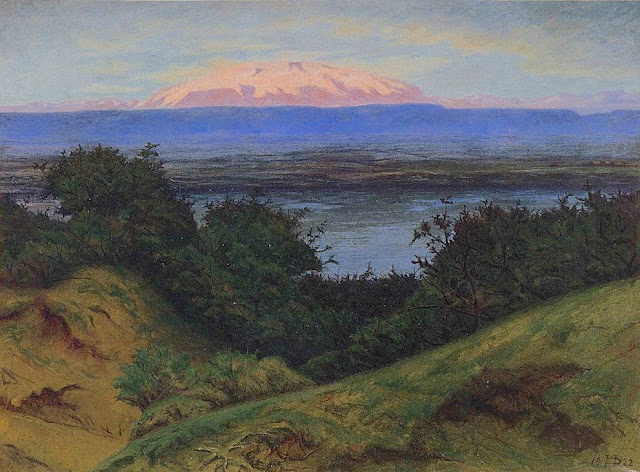France (Provence Alpes Côte d'azur)
1. In Sainte-Victoire vue du Mas de Malvallat, watercoulour on paper, Musée Granet
2. In La Ste Victoire vue d'une cour de ferme, watercolour on paper, Musée Granet
The mountain
Mont Sainte-Victoire (1,011 m-3,316ft) also called Mont Venturi is a limestone massif in the South of France, in the region Provence-Alpes-Côte d'Azur. Located east of Aix-en-Provence, it has experienced international fame, due to the more than 80 works Paul Cézanne did on it. It hosts many hikers, climbers and nature lovers, and is a major element of Aix landscape.
The range of the Sainte-Victoire is 18 kilometers long and 5 kilometers from large, following a strict east-west orientation. It is located on the Bouches-du-Rhône and Var, and in the towns of Puyloubier, Saint-Antonin-sur-Bayon, Rousset, Châteauneuf-le-Rouge, Beaurecueil, Le Tholonet Vauvenargues, Saint-Marc-Jaumegarde, Pourrières, Artigues and Rians.
D 10 and D 17 (Route Cézanne) are the main roads to skirt the mountains. On the northern side, the D10 crosses the Col de Claps (530 m) and the Col des Portes (631 m). On the southern side, the D 17 walks on the Plateau de Cengle and crossed the Collet blanc de Subéroque (505 m).
The southern side is characterized by the presence of significant high limestone cliffs 500 to 700 m with the white appearance added to the sun gives the appearance of a high muraille. At the foot of the cliffs, there is more massive brush, oak, kermes oak, Aleppo pine (population greatly reduced after the fire of 1989) but also cultures (olive trees).
On the northern side among the many species present, the Crocus is fairly well represented in the hills and the wild iris and daffodil. One can also see various varieties and boxwood shrubs.
The massif rises to the Pic des Mouches (Peak of the Flies) (1011 m) near the eastern end of the chain, and not at the Croix de Provence (946 m) near the west end and visible from Aix. The Pic des Mouches is one of the highest peaks of the department of Bouches-du-Rhône, behind the peak Bertagne which reached an altitude of 1042 mètres and which is located on the massif of Sainte-Baume.
Sainte-Victoire, as the range of the Sainte Baume, can be considered a special case among the Alpine ranges for the various stages of the formation of its relief associated geological history as well as that of the old Pyrenean-Provençal chain than that of the Western Alps (which have succeeded it).
Indeed, from the former Sainte-Victoire mountain, contemporary of the dinosaurs of the Cretaceous, it remains today only the fold Bimont, said Chaînon des Costes Chaudes, the last vestige resulting from tectonic movements and characteristics of the stacks of Pyreneo-Provençal phase during the Eocene. Later during the Oligocene, breaking of the anticlinal fold of Sainte-Victoire, which resulted from the uplift of the first great Alpine reliefs, is causing a surge that help explain the current form of the mountain, which appeared 15 million years BCE.
Sainte-Victoire, whose calcareous sediments date back to the Jurassic, thus consists of both a Pyrenean-Provencal vestige and of an alpine geology. This singularity and this ambivalence help explain why, although a massive western Alps, the problem of this connection remains complexe.
According to a recent study, the Sainte-Victoire is still growing ! The company ME2i has indeed conducted a satellite survey between 1993 and 2003 providing evidence that during this period the western end of the Sainte-Victoire was uplift of 7 mm per year.
The massif is a ensemble of 6525 ha classified since 1983.
The massive hosts several world-famous dinosaur eggs deposits including the Roques-Hautes / Les Grands-Creux on the town Beaurecueil.
The painter
François Marius Granet was a french painter born in Aix-en-Provence.
In 1793, Granet followed the volunteers of Aix to the siege of Toulon, where he obtained employment as a decorator in the arsenal. Whilst a lad he had, at Aix, made the acquaintance of the young comte de Forbin, and upon his invitation, Granet in the year 1797 went to Paris. Forbin was one of the pupils of David, and Granet entered the same studio. Later he got possession of a cell in the convent of Capuchins, which, having served for a manufactory of assignats during the Revolution, was afterwards inhabited almost exclusively by artists.
In 1802, he left Paris for Rome, where he remained until 1819, when he returned to Paris, bringing with him besides various other works one of fourteen repetitions of his celebrated "Chœur des Capucins" executed in 1811. The figures of the monks celebrating mass are taken in this subject as a substantive part of the architectural effect, and this is the case with all Granet's works, even with those in which the figure subject would seem to assert its importance, and its historical or romantic interest. Stella painting a Madonna on his Prison Wall, 1810 (Leuchtenberg collection); Sodoma à l'hôpital, 1815 (Louvre); Basilique basse de St François d'Assise, 1823 (Louvre); Rachat de prisonniers, 1831 (Louvre); Mort de Poussin, 1834 (Villa Demidoff, Florence), are among his principal works; all are marked by the same peculiarities, everything is sacrificed to tone.
In 1819, Louis Philippe decorated Granet, and afterwards named him Chevalier de l'Ordre St Michel, and Conservateur des tableaux de Versailles (1826). He became a member of the institute in 1830; but in spite of these honours, and the ties which bound him to M. de Forbin, then director of the Louvre, Granet constantly returned to Rome. After 1848, he retired to Aix immediately lost his wife, and died himself on 21 November 1849.
He bequeathed the greater part of his fortune to his native town and all his collections (including the very fine portrait by Ingres from 1811 ) to the Museum of Aix en Provence, which was renamed the Musée Granet in 1949, the centenary of his death.



















